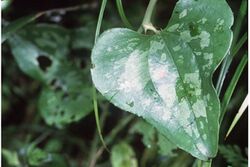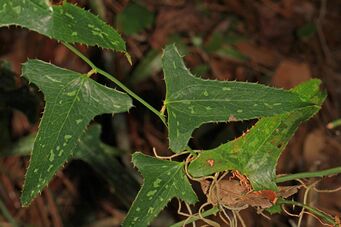Biology:Smilax bona-nox
| Smilax bona-nox | |
|---|---|

| |
| Scientific classification | |
| Kingdom: | Plantae |
| Clade: | Tracheophytes |
| Clade: | Angiosperms |
| Clade: | Monocots |
| Order: | Liliales |
| Family: | Smilacaceae |
| Genus: | Smilax |
| Species: | S. bona-nox
|
| Binomial name | |
| Smilax bona-nox | |
| Synonyms[1] | |
|
Synonymy
| |
Smilax bona-nox, the saw greenbrier, is a species of plant in the family Smilacaceae. It is native to the Southern United States, and eastern Mexico.
Description
Smilax bona-nox, also known as saw greenbrier, is a flowering vine that is prickly with a one-seeded fruit. This plant prefers full sun but can also survive in partial shade. It prefers moist soil but is tolerant of numerous soil types. They are commonly found in wooded disturbed areas. Smilax bona-nox is dioecious, meaning it is either male or female.[2][3][4][5]
Smilax bona-nox produces fruits, one seeded drupes, that are dispersed by animals. Fruits are black and blue in color. The fruits are edible to humans and wildlife. Fruit harvest is during the fall and summer months.[4]
Bullbriar, Catbriar, Dunes Saw Greenbrier, Greenbriar, Streychberry Vine, and Tramp's Trouble are common names for Smilax bona-nox.[5][6]
Distribution
Smilax bona-nox ranges across much of the eastern part of the U.S. It is distributed as far south as southern Florida, west to the edge of Texas and eastern Mexico, north to Maryland, Kentucky and southern parts of Indiana and Illinois, Missouri and Southeastern Kansas. Smilax bona-nox also occurs in Bermuda and Mexico.[5]
Smilax bona-nox are dispersed by being eaten and passed by wildlife. Mainly small animals and songbirds partake in their fruits but they are also eaten by deer and black bears.[7]
Cultivation
Smilax bona-nox is easy to grow by seed, and should be grown near lattice work or near something it can climb. This is a climbing plant that needs something to hold on to. It should also be given plenty of room as it will grow quickly and will shade other plants.[8]
Ethnobotany
Smilax bona-nox has many uses. The leaves of this plant were used for cigarette wrappers by the Native Americans. The roots can be used not only to make bread but also as medicines. The roots of this plant are known to help urinary tract infections and as an antioxidant.[4]
Edibility
Smilax bona-nox is edible whether cooked or not. If cooked, the roots can be made into a gelatin replacement if ground into a powder. Younger shoots are edible raw or cooked. The fruits are also edible; they are black and blue.[4][9]
Control
Smilax bona-nox can be controlled with herbicides but has been known to adapt to the effects of it. It has also been known to not be affected at all. Some herbicides have been known to also help it grow instead of causing it to die. Smilax bona-nox can also be controlled by fire but it returns due to respiration.[10]
Wildlife
Many animals use the fruit of Smilax bona-nox as food, including wood ducks, ruffed grouse, wild turkey, fish crows, black bears, opossums, raccoons, squirrels, and multiple species of songbirds. Both the leaves and fruit are occasionally eaten by white-tailed deer.
The leaves and growth of the plant are used for shelter for smaller mammals. It is used to help smaller mammals to hide from both larger mammals and predator birds. The prickles on the plant are for protection from larger herbivores.[4]
Fire ecology
The Smilax bona-nox is tolerant to the occasional control burns and natural fires. Because they have rhizomes under ground, they can still sprout even when they have lost the tops of their plants. Corm-like forms can grow along with their rhizomes.[11]
References
- ↑ Kew World Checklist of Selected Plant Families
- ↑ "Smilax bona-nox | International Plant Names Index". https://www.ipni.org/n/541314-1.
- ↑ "USDA Plants Database". https://plants.sc.egov.usda.gov/home/plantProfile?symbol=SMBO2.
- ↑ 4.0 4.1 4.2 4.3 4.4 "Smilax bona-nox (Bullbriar, Catbriar, Dunes Saw Greenbrier, Greenbriar, Saw Greenbrier, Stretchberry Vine, Tramp's Trouble) | North Carolina Extension Gardener Plant Toolbox". https://plants.ces.ncsu.edu/plants/smilax-bona-nox/.
- ↑ 5.0 5.1 5.2 "Smilax bona-nox". https://www.fs.fed.us/database/feis/plants/vine/smibon/all.html.
- ↑ "Smilax bona-nox L. — The Plant List". http://www.theplantlist.org/tpl1.1/record/kew-288543.
- ↑ "Smilax bona-nox". https://www.fs.fed.us/database/feis/plants/vine/smibon/all.html#12.
- ↑ Cullen, James (February 2006). "544. Smilax Bona-nox 'Cantab'. Smilacaceae". Curtis's Botanical Magazine 23 (1): 25–29. doi:10.1111/j.1355-4905.2006.00508.x. ISSN 1355-4905. http://dx.doi.org/10.1111/j.1355-4905.2006.00508.x.
- ↑ "Useful Temperate Plants". http://temperate.theferns.info./.
- ↑ Janak, Travis Wayne (2011). Evaluation of Various Herbicides for Saw Greenbrier [Smilax bona-nox L.] and Southern Dewberry [Rubus trivialis Michx.] Control and Bermudagrass [Cynodon dactylon (L.) Pers.] Tolerance and Sharppod Morningglory [Ipomoea trichocarpa var. trichocarpa Ell.] Control in Roundup Ready Flex® and LibertyLink® Cotton Systems (MS). Texas A&M University.
- ↑ Hulnik, Frank Wayne (1974). Effect of Fire on the Growth of Rhus Glabra L. and Smilax Bona-Nox L. (PDF) (MS). Oklahoma State University.
Wikidata ☰ Q7544549 entry
 |




